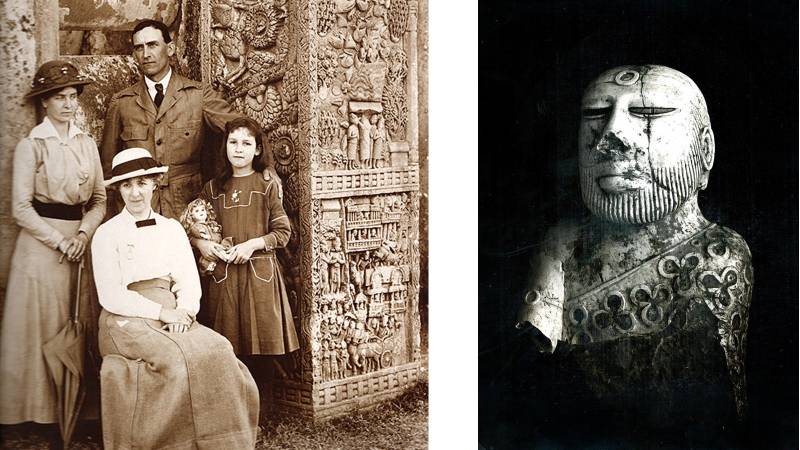
Sir John Marshall was Director-General of the Archaeological Survey of India during a crucial period from 1902 to 1928. He supervised the excavations of Harappa and Mohenjodaro, the most famous sites of the Indus Valley Civilisation.
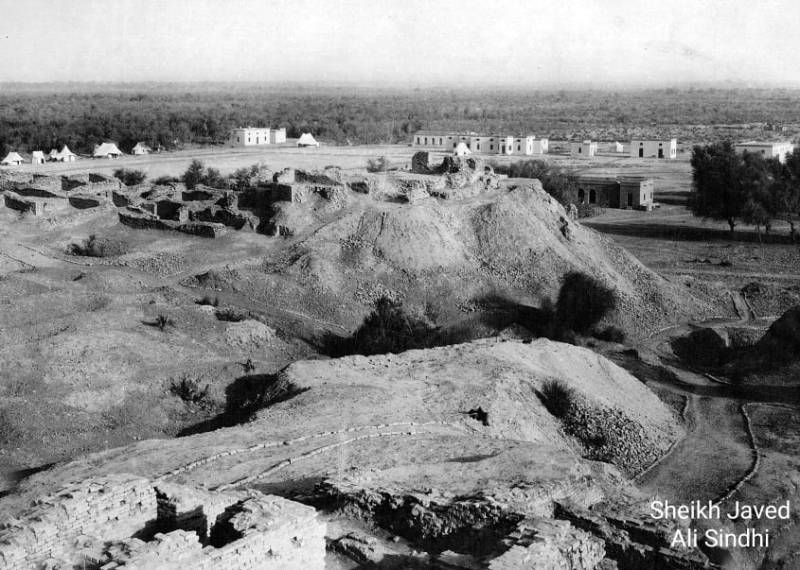
Excavation work begins in 1923-24 at Mohenjodaro
The excavation work was initially supervised by MS Vats and then by KN Dikshit. Marshall writes in his book Mohenjodaro and the Indus Valley Civilisation:
“During the two following seasons attention was, at my request, concentrated on the opening of trial trenches across the main groups of mounds to the east. In the first of these seasons (1923-24) Mr MS Vats, who had temporarily relieved Mr Banerji as Superintendent in Western India, sank two long trenches –one north to south and the other east to west-across the VS Area. His work, unfortunately, was hampered by continued shortage of funds, and it was only that a very few points that he was able to expend the digging and clear some of the structures disclosed. Nevertheless, he accomplished enough to demonstrate that this quarter of the site was occupied, right up to the surface, by remains of the Chalcolithic Age, and that these remains consisted mainly of the houses of the well-to-do classes. He also established the fact that there were several distinct strata of remains lying one below another down to the level of the subsoil water” (Page 11)
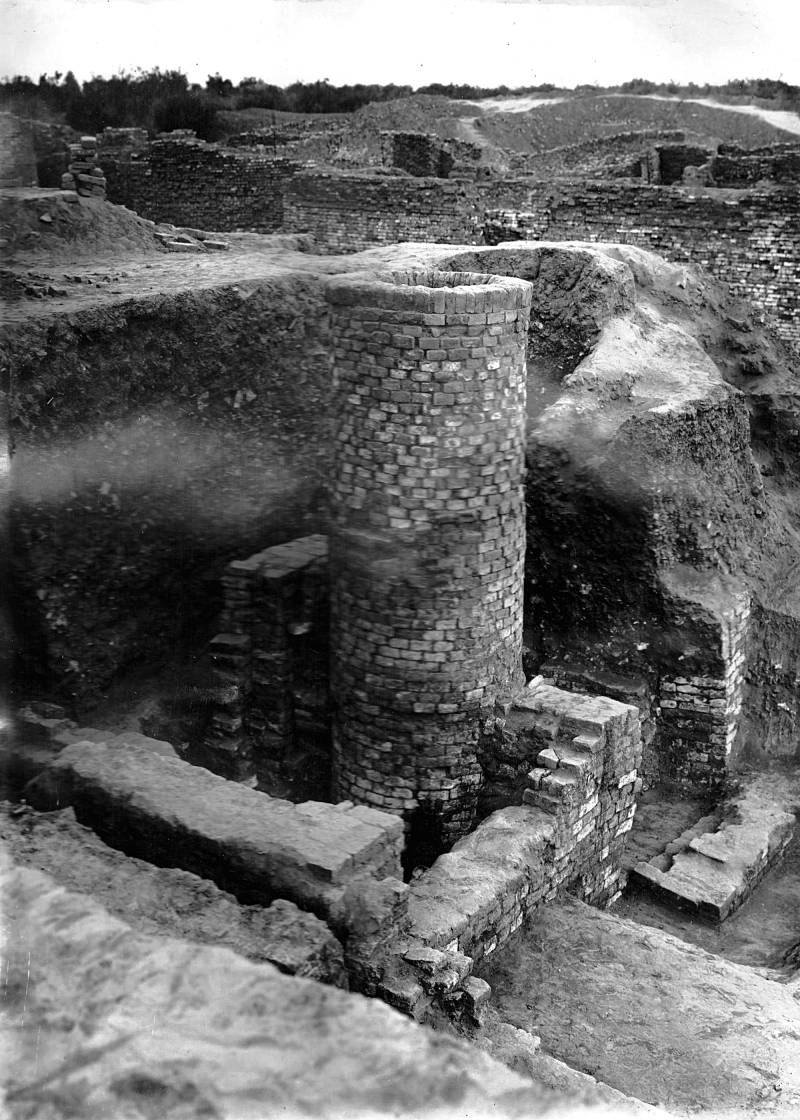
Further, Marshall writes:
“In the next season (1924-25) Mr KN Dikshit happily had more labour at his command, and was able to continue this trenching work on a bigger scale. The trenches which he dug were all in the DK Area to the north –east of the VS Area. They completed a series of short trenches in the mounds A, B, and C, and the longer ones lettered D and E, the last of which cuts right across the northern part of the mounds from east to west. Besides sinking these trenches, Mr Dikshit also partially cleared several of the more important buildings or groups of buildings through which these trenches cut, and recovered a large number of minor antiquities, including some of the most valuable that Mohenjo-daro has yet produced. Preliminary accounts of his and Mr Vat’s discoveries have already appeared in the Annual Reports of the Archaeological Department, with a number of illustrations, some of which are not reproduced in these volumes.” (Page 11 and 12)
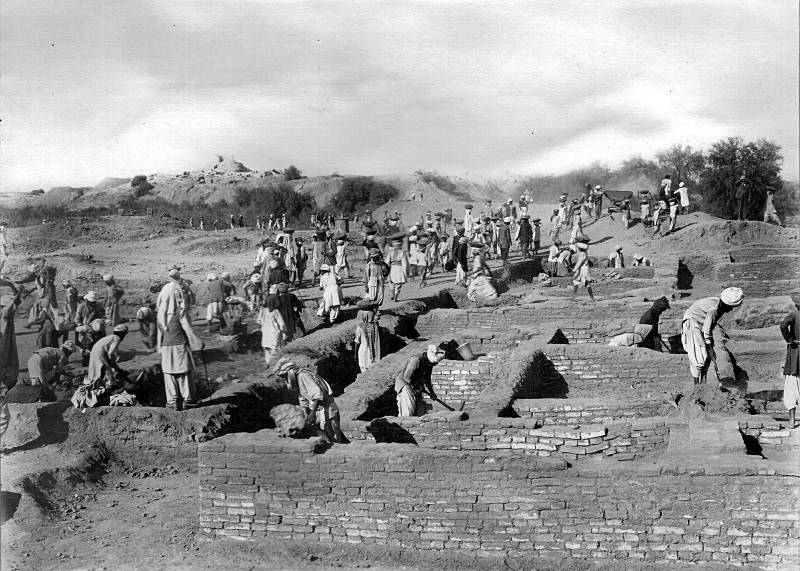
According to Marshall,
“The Buddhist monuments on the summit of this mound were mainly excavated by Mr RD Banerji in 1922-23; the deeper digging in the prehistoric strata beneath them was started by Mr Banerji, but chiefly done by Mr BL Dhama under my own direction in 1925-26.” (Page 113)
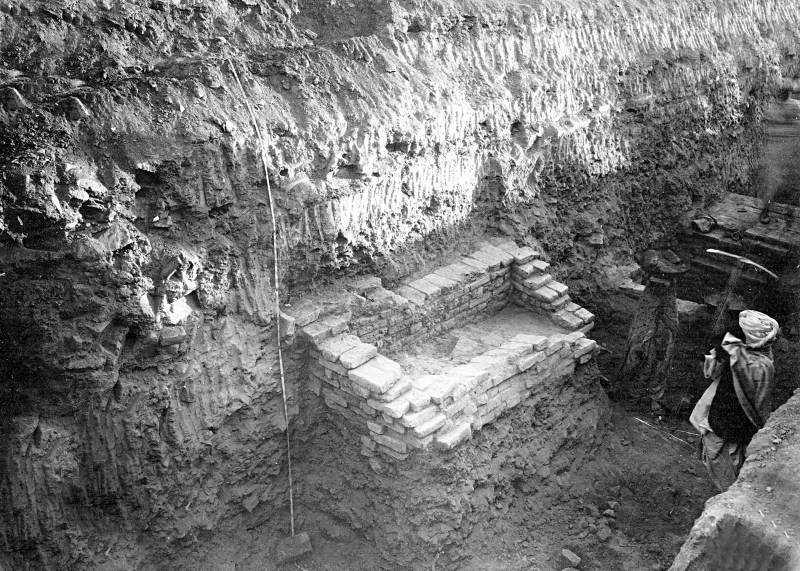
Sir John Marshall’s visit to Mohenjodaro for massive excavations in 1925
Describing his own visit and the gradual realisation of the significance of these Indus Valley Civilisation sites, Marshall writes:
“By the time these trial diggings were finished, we had simple evidence that Mohenjo-daro was a site of exceptional promise, where the excavator could get back at once to the Chalcolithic Age, without the toil and expense of removing letter accumulations, and where he would be sure of finding well built structures and other remains in a reasonably in good state of preservation. It was clear to me, however, that if we were to excavate this site on scale compatible with its importance, we must be prepared to launch a much more ambitious campaign than had hitherto been feasible. Fortunately for my ideas, the discoveries which had already been made here, coupled with those at Nal, Harappa, Taxila, Nalanda and other sites, were now rousing such widespread interest that there was little difficulty in persuading Government to agree to a more liberal programme and to accord permission to my concentrating for a season at Mohenjo-daro as many of my officers and their assistants as could be spared from Northern and Western India.
My reasons for seeking this permission were not merely that the campaign of excavation which I had in view would demand a very much increased staff, but that it was already becoming evident that the Indus Culture represented at Mohenjo-daro extended over a very wide area, including Sind and the Panjab, if not other large tracts to the east and west; and I was anxious that the officers on whom would fail the task of following up this civilization, should have this opportunity –an opportunity not likely to recur-of collaborating together on one and the same site and of familiarizing themselves with the newly found antiquities as well as with the most up-to-date methods of excavating and preserving them.” (Page 11 & 12)
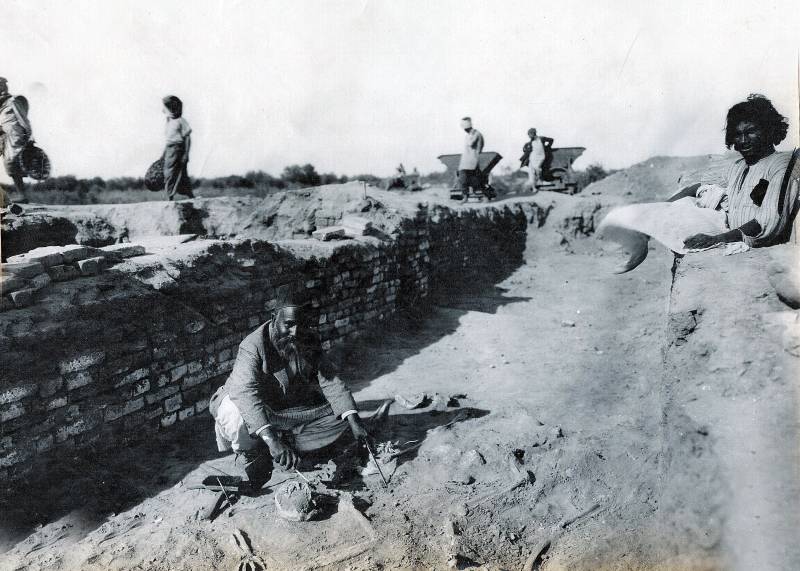
Staff of officers and division of work 1925-26
He describes the personnel involved as follows:
“The officers assembled for this purpose were Mr H Hargreaves, then Superintendent of the Frontier Circle; Mr MS Vats, Mr KN Dikshit, Mr BL Dhama, Assistant Superintendent in Rajputana and Central India, and Mr Sana Ullah, our Archaeological Chemist. This controlling staff enabled me to employ effectively a body of from 1,000 to 1,200 labourers. These I divided into four groups: one to work under Mr Hargreaves on the HR Area, a second under Mr Vats on the VS Area, a third under Mr Dikshit in the DK Area, and the fourth under my personal supervision with the help of Mr Dhama and of my Excavation Assistant from Taxila, Mr AD Siddiqi, on the northern half of the Stupa mound.
In the course of the season Mr Hargreaves excavated all the part of the HR Area which lies to the east of First Street, together with the street itself and a strip of the buildings on its west-as much of this area, that is to say, as is described by him in these volumes; Mr Vats expanded his previous trench-digging and cleared both A and B sections, with the exception of those buildings which lie to the east of First Street and a few at the southern fringe of B section; Mr Dikshit returned to the scene of his former labours on mounds B and C, and opened out the groups of buildings shown on Pls LXI and LXII; while I myself unearthed the Great Bath and other blocks of buildings in the SD Area, and explored as far as was possible the earlier remains beneath and around the Buddhist monastery.
My primary object in all these areas was to clear the uppermost strata down to such depth only as might be practicable, without having recourse to dismantling. The later remains are of such interest in themselves and generally so well preserved, that I was most reluctant to remove any part of them for the purpose of penetrating the earlier strata underneath, at any rate until we had had ample time for their study and could be sure that we were removing nothing of vital importance. This same principle was again adhered to by Rai Bahadur Daya Ram Sahni in the succeeding year, and explains why up to the close of 1926-7 relatively little stratigraphical evidence was recovered.” (Page 12 & 13)
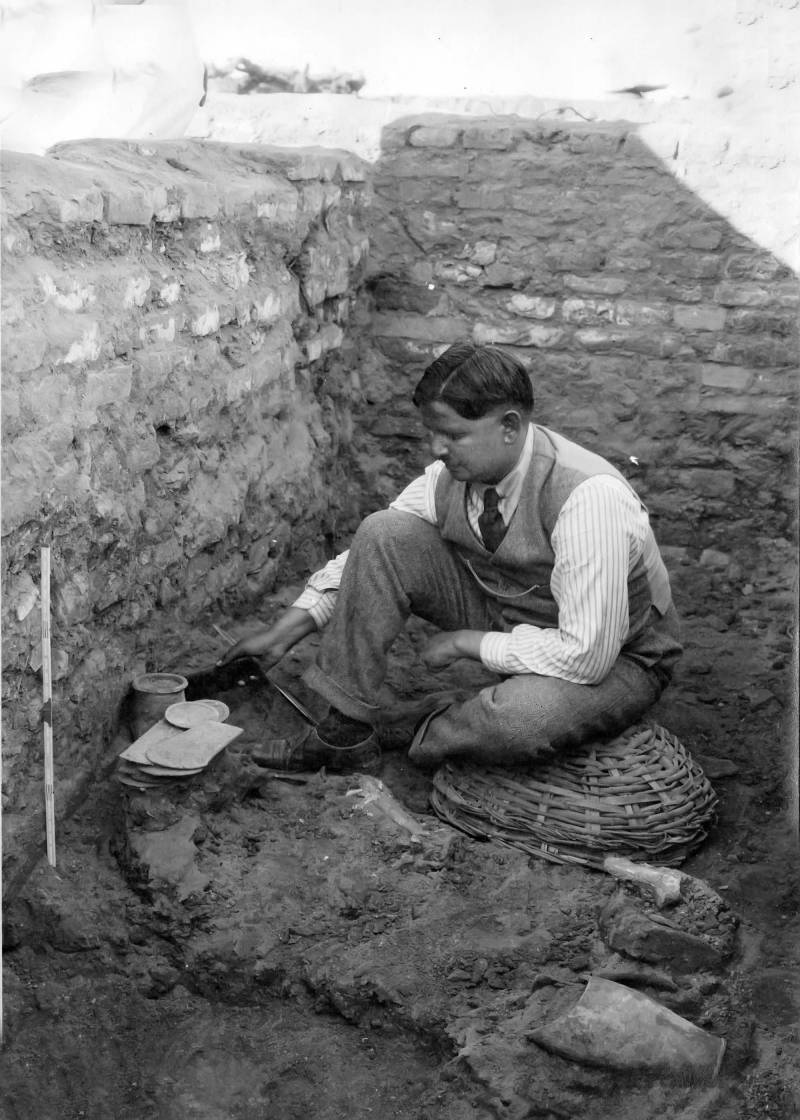
Construction of road and offices and survey of the site
About the necessary infrastructure for the excavations, Marshall writes:
“Besides carrying out these extensive operations in 1925-6, I was also able, thanks largely to the interest taken in the work by Sir Leslie Wilson-then Governor of Bombay-to get a serviceable road made to Mohenjo-daro from the Railway station at Dokri, and which was more important still-to erect adequate offices, workrooms, and quarters, and a small museum for the housing of antiquities. Accurate plans of the site were also prepared under my direction by Mr A. Francis, of the survey of India, on a scale of 100 feet to the inch, with contours at 5 feet intervals. These plans have been used in compiling the general but more simplified site plan which accompanies this volume.” (Page 13)
Appointment of a full-time officer for Mohenjodaro
In time, Marshall came to see the need for a dedicated archaeologist to oversee the work:
“From the foregoing it will be observed that up to the close of 1925-6, the operations at Mohenjo-daro had been directed by four successive officers, each of whom had multifarious other duties to perform and could give only a limited part of his time to the work each season. This frequent change in the direction of the work was manifestly a weakness, but it was a weakness which up to then it had not been possible to avoid. In the interest, however, of continuity and the systematization of results, it seemed to me eminently desirable that an officer should be placed in charge who could concentrate his undivided attention on this task, and, as there was no one in the Archaeological Department who could be permanently spared for this purpose, I determined, if possible, to get an archaeologist from outside with a first-hand knowledge of prehistoric excavations in Sumer and Western Asia”. (Page 13)
“As already stated, I was peculiarly fortunate in being able to secure the services of Mr Mackay. As Mr Mackay, however, was unacquainted with local conditions in Sind or the ways of Indian administration, it was not possible for him to assume immediate direction of work. In the winter season of 1926-7, therefore, it was arranged for him to work under Rai Bahadur Daya Ram Sahni, an excavator of wide experience in India, and between them they added two important plots to those already excavated, the Rai Bahadur devoting himself mainly to the HR and VS Areas, Mr Mackay to the L Area in the Stupa mound. In the HR Area the former officer took up the work begun by Mr Hargreaves in the previous season and cleared most of the ruins west of the First Street, while in the VS Area he rounded off Mr Vats’ excavations on the south and cleared some more buildings on the east side of First Street. In L Area Mr Mackay was responsible for the exaction work of the entire group of ruins as they stand at present.”(Page 13)
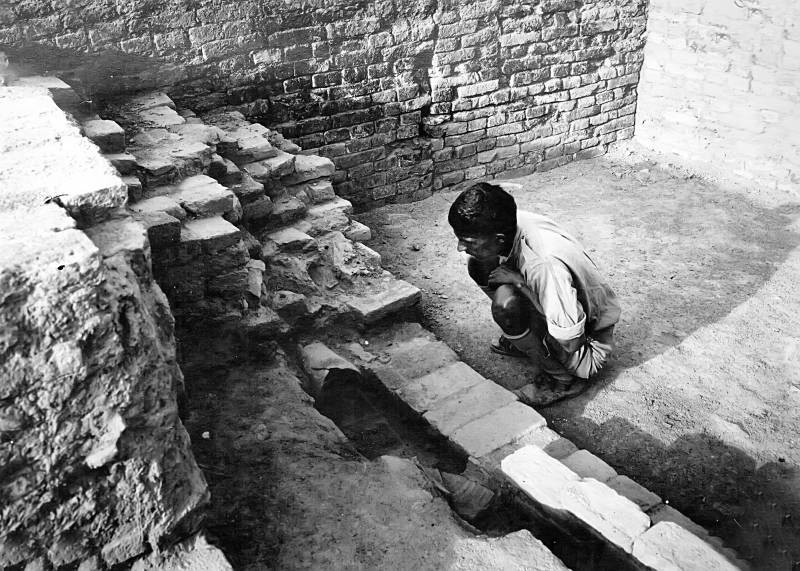
Descriptive Accounts of the Excavations
Marshall writes in Mohenjodaro and the Indus Valley Civilisation:
“It was a pity that for the purpose of this publication arrangement could not be made for each of the excavators to contribute the description of his own discoveries. Preliminary accounts of most of the work done have already appeared in the Annual Reports of the Archaeological Department, and in the case of HR and L Areas Mr Hargreaves, Rai Bahadur Daya Ram Sahni and Mr Mackay have each continued a chapter describing the results of their digging. It was not possible, however either for Mr Vats or for Mr Dikshit to collaborate in these volumes. Accordingly the excavations done by the former in the VS Area have been described by Rai Bahadur Daya Ram Sahni, and those done by the later in the DK Area by Mr MacKay. Mr Mackay has also contributed a description of the Great Bath and neighbouring buildings discovered by me in 1925-6, which I am myself responsible for the chapter on the Stupa Area and earlier ruins beneath it, which were partly explored by Mr Banerji in 1922-3, partly by myself in 1925-6.
The remains brought to light by Mr Banerji in sites 2 and 3, to which allusion has been made above, are not dealt with in the present publication, for the reason that their clearance had not proceeded far enough for any tangible conclusions to be reached. They will be reserved, therefore, for a later volume, when their excavation is more complete. Let me add that in writing the chapter on the Stupa Area I had access to a lengthy manuscript article by Mr Banerji describing the results of his labours at Mohenjo-daro in 1922-3. This article not being suitable for inclusion in this work, the author of it was authorised by the Government to publish it, if he so wished, independently.” (Page 13 and 14)
Sir Aurel Stein visited Mohenjodaro in 1926
Hungarian-born British archaeologist Sir Aurel Stein came to Mohenjodaro in 1926 where he met with Sir John Marshall. With the support of Sir John Marshall and the Government of India, he started expeditions to Balochistan. In the year 1926-27 he started from Waziristan, DI Khan, Sandeman Fort in Zhob, Loralai, and Pishin. Mr QM Moneer assisted him in publication of the report of his excavations. During 1927-28, he focused on Makran and Lasbella. Later on he surveyed area of 200 miles from Kalat to the Persian border and 250 miles from Kharan to the Arabian Sea coast. Stein inspected some 150 sites and surveyed 65 sites along with excavations at 15 locations. The areas of Jhau/Khuzdar, Jhalawan and Sarawan were also surveyed which is considered by Possehl as the only extensive archaeological exploration in ancient Gedrosia.
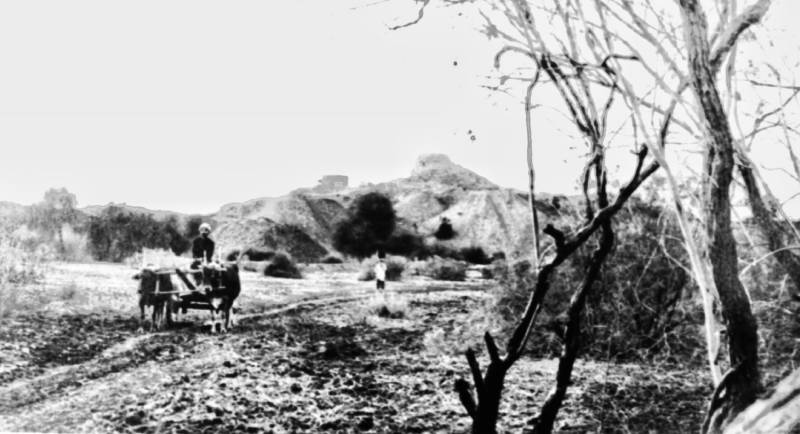
He discovered thousands of antiquities including painted ceramic wares, terracotta figurines, stone implements, etc. This report was published with the title of An Archaeological Tour to Gedrosia-1931. Sir Aurel Stein died on October 26, 1943 at Kabul Afghanistan. He lived a bachelor’s life.
General Observations on the Excavation Work
The following observations by this author are based on old photographs taken at Mohenjodaro during 1922-23, 1924-25, 1925-26, 1926-27, 1927-28 and 1928-29. These photos were also published in the Sindh Volumes later.
- Sir John Marshall employed a body of from 1,000 to 1,200 labourers at Mohenjodaro. Mostly they were living in thatched huts; fixed around the archaeological site. According to Bheru Mal Meharchand Advani’s (1875-1950) book Qadeem Sindh published in 1944, a majority of labourers at Mohenjodaro were Brahuis who mostly came from the Kalat region of Balochistan to earn their bread in Sindh. As there was shortage of labour, these tribesmen were employed as workers in the excavations.
- A jungle had always been present around Mohenjodaro. At first this jungle was paid attention; the workers uprooted vegetation, grass, brush wood, trees and plants.
- Most of the labourers used to wear turbans, shawls, dhoti, and shoes to protect them from severe cold. Some of the poor employees worked barefoot from morning to evening. The archaeological officers and staff wore British/ Indian attire with coats, hats and shoes. The supervisors oversaw the ongoing excavation work regularly. They carried sometimes a large stick on which they stood for several hours. Some of the workers were fond of the hubble-bubble, a hookah.
- Some of the labourers included women who cleaned broken antiques or potsherds in tubs filled with water. This water was taken out from ancient wells which were situated around the Buddhist Stupa and Monastery in SD Area. Sometimes these women carried their children and walked through the excavated areas to entertain them. Some women belonged to Brahui tribes whose men were mostly employed in excavation work. Dogs followed their masters during excavation work. Some of the labourers even brought bird cages with them during excavation work.
- A number of hardworking donkeys carried earth from HR Area and emptied soil bags outside the excavated areas. These donkeys were driven by male and female labourers. The women were clad in colourful Saris. It seems that these women labourers were brought from Tharparkar, the desert of Sindh.
- Some Medical First Aid Boxes were placed near the excavation work to treat minor scrapes, cuts, snake/insect bites and other injuries.
- The excavation work was carried out with spades, shovels, buckets, baskets, wheelbarrows, brushes, measuring tapes and other tools. Zambeli was a large rubber bucket which was used in trenches. It removed the soil from the site. The workers carried a Zambeli on their heads.
- There were many Chaukidars’ Huts in Mohenjodaro where Chaukidars performed their duties. Such huts were built in SD, HR and other areas. Tents were fixed for ASI Officers and supervisors. The officials worked on wooden tables and chairs for drawing plans and maps. Terracotta water vessels, glasses and flowerpots were placed over tables. Sometimes ASI Officers and supervisors also took umbrellas over their heads to protect from the sun. Excavation work photographs were taken with inverted camera.
- Water Carts were used to provide drinking water for labourers working in the ruins during excavations. These iron carts were drawn by bullocks.
- The labourers used to carry a Zambeli on their heads in straight lines from one place to another. These roads were decorated with bricks fixed from both sides.
- Broken bricks were collected and placed in large piles in different excavated areas.
- The removal of dirt/soil was done through large mining trolleys which were driven on small railroads by the workers. These were emptied in debris outside the excavated area of Mohenjodaro. Such Trolleys are shown in old photos taken in the Stupa and DK areas between 1926-27.

